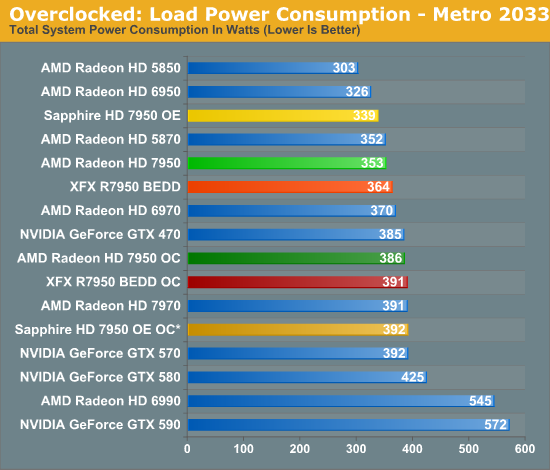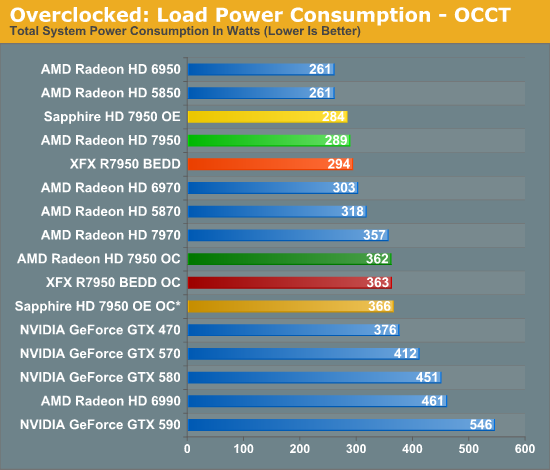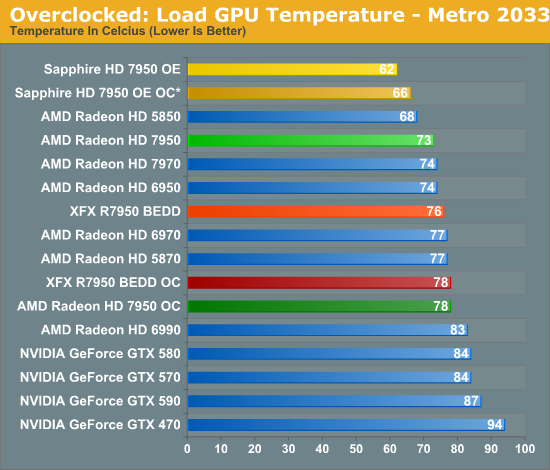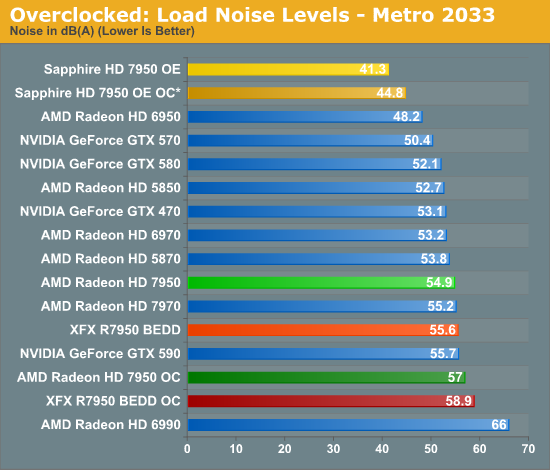AMD Radeon HD 7950 Review Feat. Sapphire & XFX: Sewing Up The High-End Market
by Ryan Smith on January 31, 2012 9:02 AM ESTOverclocking: Power, Temp, & Noise
In their marketing materials AMD is heavily pushing overclocking, and they have good reason to. With the 7970 we’ve established that Tahiti has quite a bit of overclocking headroom, and as the 7950 is clocked lower by default this opens up that headroom even further. Realistically AMD’s binning process means that the best clocking Tahiti GPUs are going to be allocated to the 7970 unless they have failed shaders, but even with that there’s quite a bit of potential on paper.
As with overclocking the 7970, our goal overclocking the 7950 is to see how much you can get for free; that is without any voltage adjustments. AMD’s reference PCBs are not particularly overbuilt for overclocking—cards like that will come later—so sticking to the reference voltage is the safest option, not to mention the easiest. With the 7970 we were able to get 200MHz (22%) overclocks without any voltage adjustment, and we’re hoping for the same out of the 7950.
With that said, we quickly ran into a wall on one card: the Sapphire 7950. Sapphire’s low VID of 0.993v may be great for temperature and noise at stock, but it’s not doing overclocking any favors. We only hit 950MHz at that voltage. As the Sapphire was the odd man out—every other card was at 1.093v—we did end up overvolting the Sapphire to 1.093v to see what it was capable of when put on similar footing as the rest of our cards.
After bringing up the voltage of our Sapphire card, all of our 7950s ended up overclocking to very similar levels. Our Sapphire and AMD cards topped out at 1025MHz core, a 225MHz (28%) overclock over a stock 7950 and a 125MHz (14%) overclock over the Sapphire’s factory overclock, while our XFX card reached 1050MHz, a 150MHz (17%) overclock beyond XFX’s factory overclock. Meanwhile the memory clocks on all of our cards topped out at 5.8GHz, beyond which we’d start seeing performance regressions from error correction on the memory bus.
| Radeon HD 7950 Overclocking | |||||
| AMD Radeon HD 7950 | Sapphire HD 7950 Overclock Edition | XFX R7950 BEDD | |||
| Shipping Core Clock | 800MHz | 900MHz | 900MHz | ||
| Shipping Memory Clock | 5GHz | 5GHz | 5.5GHz | ||
| Shipping Voltage | 1.093v | 0.993v | 1.093v | ||
| Overclock Core Clock | 1025MHz | 1025MHz | 1050MHz | ||
| Overclock Memory Clock | 5.8GHz | 5.8GHz | 5.8GHz | ||
| Overclock Voltage | 1.093v | 1.093v | 1.093v | ||
As you can imagine, with such similar overclocks, gaming performance on all 4 cards ended up being very similar. So we’ll get to gaming performance in a minute, while we’ll start with power, temperature, & noise.


Even though we’re not increasing the voltage on our AMD and XFX cards, merely overclocking them and raising the PowerTune limit to avoid throttling does drive the power consumption up. As is typical with heavily overclocked cards, overclocking quickly drives up power consumption and the 7950s are no exception. After overclocking power consumption is almost identical to the stock 7970, so while you can get 7970 performance you still need to pay the price with 7970 power consumption. Meanwhile it’s interesting to note that even with the extra 0.1v we’ve given the Sapphire card its final power consumption is only ever so slightly higher than the other 7950s, proving that voltage is the great equalizer in this case.


With the increase in power comes an increase in temperatures. The Sapphire card still does very well here staying in the low 70s even under OCCT, while the reference and XFX cards hit the high 70s under Metro and mid 80s under OCCT. As we’ve yet to really ascertain what the thermal limits are for Tahiti, it’s not clear whether there’s too much thermal headroom left for the GPU, particularly under OCCT.


Last but not least we have load noise. The Sapphire card is once more a stellar performer, and we still can’t get it above 50dB even with OCCT. Unfortunately the XFX 7950 BEDD has its biggest fallout yet—it may be able to overclock well, but at 64dB under OCCT the performance isn’t going to be worth the immense amount of noise it creates to move enough air to keep the GPU cool.










259 Comments
View All Comments
Galidou - Sunday, February 5, 2012 - link
Yeah and then they took out a 8800gt priced so low that they did cut their own leg themselves, lol it was ridiculous, everyone that bought a 8800gts and 8800gtx felt they had been fooled once more by the green goblin :/First time for ATI mispricing their video card higher and look the green goblin fans are all mad...
xeridea - Tuesday, January 31, 2012 - link
Cards always cost more on release as there is built up demand and stock is low. You could have gotten almost as good of performance a year ago... if you don't care about using nearly 100W more power under load, and run 10-25C hotter. There are still 580s selling well over $500 BTW. The Sapphire card has a distinct performance advantage, uses little power, runs 27C under load cooler, near silent, and is cheaper than the average price of the 580.Newegg prices its $20 cheaper than cheapest 580, is faster on average (still fairly new drivers), uses a _LOT_ less power (load and idle), Zerocore power, and a lot cooler all around.. Yeah I would say that is competitive.
Price will surely go down, especially when Nvidia finally gets off its butt and releases its next generation 3 months from now, but it won't make AMD look bad, they will just adjust prices.
OCedHrt - Tuesday, January 31, 2012 - link
AMD is likely charging a premium while it can. Why would it want to significantly undercut NVIDIA pricing which will force NVIDIA to lower their prices as well. It's all about margin, hopefully.Galidou - Sunday, February 5, 2012 - link
Well that's because it's Nvidia's job usually to price their video card higher than they perform, so the green goblin fans are mad because for the first time, AMD fans and rich kidz will buy overpriced video card from the competitor.CeriseCogburn - Sunday, August 26, 2012 - link
LOLamd fanboys are still whining about price, 8 months later, after nVidia drove down their crapship $170 and 3 free games.
Let's face it, amd fanboys are the price whiners. Then after extensive whining, they claim, after the huge 33%+ discounts and free games, that's it's still too high so they will pinch $10 and get the slower amd card, or spend $30 more and get the slower amd card....LOL YES that's what they do.
yankeeDDL - Tuesday, January 31, 2012 - link
Chizow,either you have a very distorted perception of reality, or you're an Nvidia fanboy.
AMD is selling the 7950 at the same price of Nvidia's 580, with the difference that the 7950 has lower power consumption (and noise, and temperature ...) and a plethora of extras.
If you have any clue about what marketing is, you would know that it would be very stupid to lower the price further. They already offer more for the same price: no need to make it any more attractive.
And seriously: do you think that Nvidia, or any other company, in that position, would drop the card prices by $100? Seriously?
If and when Kepler arrives, and if the performance is where it needs to be, then Nvidia will be welcome to lower the prices, and AMD will be forced to follow. It is called competition: that's why it is good to have two (or more) player in a market, not a monopoly.
chizow - Tuesday, January 31, 2012 - link
Again, what don't you understand in my 'distorted view of reality'? I've already laid it out and many others have agreed. What AMD is doing here is unprecedented by pricing their next-gen parts according to last-gen performance.I asked someone else this, but what do you think the reaction would be if Nvidia took 14 months to respond to SI with a "next-gen" part that was only 15-25% faster than the 7970 but cost 10% more, or launched a 7950 equivalent for the same price? There's no progress there....
I mean at that point, even the Nvidia fanboys would declare epic failure don't you think? It makes you wonder why the ATI fanboys don't see it the same way.
As for marketing and competition and all that, you don't seem to get it. At the current prices, AMD makes it very hard for even their own users to justify the cost of these parts. The performance just is NOT there relative to the price when compared to last-gen parts. If they priced these cards more reasonably and similar to their last-gen parts, it would be a no-brainer. But the fact of the matter is, this level of performance was available at this price over a year ago.
yankeeDDL - Wednesday, February 1, 2012 - link
Chizow,what you said the 1st time was clear. No point on repeating it.
You're convinced that AMD should lower the price: frankly, I don't care to explain you why you're wrong. I already said it: the 7950 uses lower power, is less noisy and has more features than the 580, and it offers a (little) higher performance.
ANYONE today buying a 580 would be stupid as they would be getting less for the same price.
So, today, AMD has no reason, whatsoever to lower the price of 7950. AMD is not in business for charity, nor is Nvidia, so if you expect miracles (price-wise) you're in for a surprise.
chizow - Wednesday, February 1, 2012 - link
Right, there's no point in anyone buying a 580 now, just as no one has any reason to buy a 7950 today. If they wanted that level of performance, they could've gotten it any time in the last 14 months for the same price. If they were willing to pay for it, they already have a 580.If they felt the price for that level of performance was too high, they most likely have something in their rig already that fits that price performance metric, and the 7950 does NOTHING to shift their position. There is no incentive for someone who has a 6970 who is getting 85-90% of the 7950's performance to pay 50% more to "upgrade" when they obviously didn't feel that was worth it 14 months ago.
Similarly, do you think it is worth it to "upgrade" to a 7950 if you already own a GTX 580? Of course not! There's simply not enough incentive, and this is why AMD's pricing of this part fails (amongst many other reasons). Does that make sense?
B-Unit1701 - Wednesday, February 1, 2012 - link
What I want to know is where you got this idea that new GPU releases are 'answers' to the other guy's last release? Each new iteration of GPU tech from either side is an improvement or shrink of their own last release putting out more performance. The generation after is already half way thru design phase when the competition unveils their new card, the FASTEST an 'answer' could be developed is 2 generations, and more likely 3.The mistake your making is that assuming that the 580 was the bar AMD was shooting for. It wasnt. They were looking to introduce their new architecture without loosing ground. Looks like nVidias failure with Kepler will enable just that, time to tweak the new design to get the kind of performance numbers you expect to see from a 'next generation' product.